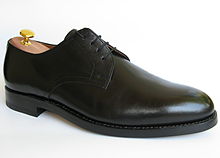Derby (shoe)
The term Derby describes a classic shoe model, which is characterized by an open lacing and the Derby shaft cut, which are formed by the two side parts coming from the heel seam and resting on the front part of the shaft.
Historical
Derby (in English usage also Gibson, in French Molière, and - incorrectly - sometimes also called Blucher in North America ) dates from the beginning of the 19th century. The origin is not entirely clear, but one of the Counts of Derby had problems closing his shoes due to his high instep. As a result, his shoemaker developed this shaft cut for his shoes.
Identification and delimitation
The Derby is not only a basic shoe model, but also and especially a special shaft cut. This shaft cut is based on many other shoe models, for example the Norwegian or the Budapest . Therefore, in common parlance, the derby cut is often used when referring to an open lacing and two quarters lying on the front leaf.
The outer shaft of the Derby consists of three parts: a front sheet and two quarters. Quarters are the side parts of the shaft beginning at the heel seam, which are sewn onto the front of the front sheet (front part of the shaft of the shoe that ends in the tongue towards the foot) and with the so-called derby bar (see illustration: the short piece of seam below the eyelet ), an additional very short reinforcement seam, can be secured against tearing. Typical of the shape of the two quarters in the classic derby is the derby arch, the upwardly arched lower edge in the front section.
The Derby can be easily distinguished from its model counterpart, the Oxford , as it has a leaf cut (closed lacing).
The Derby is often confused with the Blücher , which also has an open lacing, but a different shaft cut.
variants
The derby arch described above, i.e. the course of the lower front edge of the rear side parts (quarters), can be different:
- classic derby
- arched
- Steilderby
- rising more or less straight from bottom to top at a steep angle
- Spitzderby
- the anterior lower angle of the quarters is acute and directed forward
- Moccasinderby
- Like the moccasin, the front leaf has an additional leaf insert
The Derby can undecorated, with cross-cap (Captoe) or with perforated ornaments ((plain) Halfbrogue ) and wing cap ( Fullbrogue be manufactured). A derby can be a shoe or a boot (derby boot).
Practical features and uses
Compared to the Oxford, the Derby is a rather sporty, not so elegant shoe model. The overall effect and the possibilities of the clothing combination depend on its design , the sole material, the color of the upper leather and any decoration. High-quality (welted) undecorated derbies can be combined with both business clothing and jeans. The derby is therefore also considered to be the most versatile shoe model.
The Derby's shaft cut is practical for people with a high instep because the tension caused by the lacing starts at the bottom of the shoe and the lacing can be opened wider overall. This also makes it easier to get started, compared to a shoe model with a closed lacing (Oxford).
literature
- Helge Sternke: Everything about men's shoes . 2nd Edition. Nicolai Verlag, Berlin 2011, ISBN 978-3-89479-252-7 .


